Russian market of terminals in the 4Q 2003. Results of
2003.
Press release, January 19-th 2004
Statistics: Official sales of terminals
on the Russian market suggest 4 053 000 units in the 4Q while
in the third quarter the sales volume was 4 529 thousands.
Sales fell by 11.5 % and the main reason
for that - shortage of the equipment. Volume of the grey market
was 4.5%. It is the lowest for the last several
years. Total market volume in 2003 was 15 million
117 thousand of mobile terminals (these figures include
grey market).
Short description of the market situation.
For better understanding of the market situation let us return
back to the data of the 3Q. The market shares of the third
quarter are as displayed below.

Shipments of mobile terminals into Russia from mobile phone
companies are as follows. We’ve decided to provide you
with the wholesale deliveries from the manufacturers (sell-in),
instead of the retail sales:
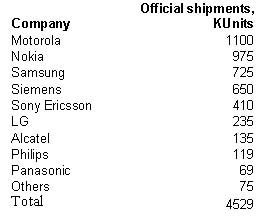
The amount of the shipments comparing to the first six
months has grown for all manufacturers. Some of them even
faced the lack of capacity; they had been unable to satisfy
the demand on Russian market. We’d like to remind you
that European market is the top priority for most manufacturers,
except for LG who are specializing on Russian market. Third
quarter’s sales were so high that the storages were
almost emptied. And now we can see a deficiency of mobile
phones in stores.
One of the reasons of deficiency is amazingly high demand
on mobile phones around in Europe, another one is underrated
predictions for Russian market made by the manufacturers.
The predictions were rather pessimistic; the sociologists
didn’t notice the growing market with high demands.
In conditions of low demand for phones in Europe the given
strategy is justified. But it stops working as soon as the
phone become highly demanded at all markets, representations
of the manufacturers are struggling to get a bigger quote
for their region. This is what had happened at the Russian
market.
Sony Ericsson can probably be recalled as a typical example.
The shipments to Russia decreased 5.5 times, from 410 thousands
to 75. The most popular model, T610 had really small number
of shipments meanwhile slightly popular T100 had large amount
of copies being sent to Russia.
The increased demand affected Siemens as well. The decrease
of the shipments was not so significant, however it was noticeable.
The company’s representatives marked out several times
that the demand is significantly exceeding the current offer.
This situation was occurring with almost all companies that
are represented in the Russian market. The only difference
was that one of them had the handsets, and the others didn’t.
Samsung, for example, couldn’t handle the demand for
its C100 when it was released. This lead to short rise of
retail prices for this model, since the distributors were
trying to correct the lack of handsets by their price.
Increase of sales for the second players can be used as
an indirect confirmation for this situation. When there is
no headsets from the “big four” of the manufacturers
– the small ones have occupied their niche. Their shipments
were at the highest level, and the sales went great for almost
all models in the budget and middle price segments.
When we are saying that all manufacturers were experiencing
the lack of available handsets, we’d had to exclude
Nokia. They weren’t having such problems; each distributor
was able to purchase as much handsets as he needed. The only
model that had sort of deficiency was budget model Nokia 3310,
which still remains Nokia’s most popular model on the
Russian market.
An average price for a Nokia phone is about 153 dollars
(wholesale prices for all line-up of handsets). Samsung is
the only company that has even higher average price. However
apart from other manufacturers we can see that Nokia has slower
realization of their products in the retail networks (4-5
weeks vs 3-4 in the usual case), this negatively affects on
wholesale shipments to Russia. The company put a lot of effort
during Q4 in order to fix this problem; they’ve started
working on providing the distributor status for several companies
at once. You want to know the companies names? Well, it wasn’t
hard to guess, if you are analyzing Nokia’s activity.
For example in Moscow they’ve tried to take Siemens
place in Alt-Telecom’s shop network. This negotiation
took place in Q4.
Similar situation occurred with “Svyaznoy”
shop network, who are Siemens biggest partner. Siemens sales
share in Svyaznoy decreased from 36 to 20 percent during last
year. Maxus (owners of Svyaznoy) commercial director Denis
Lyudkovsky mentioned this in an interview to Russian local
newspaper. The fact that Nokia’s products partly replace
Siemens from now on looks logical.
The third factor is company’s Anarion position, who
have made an agreement with Nokia in Q4. This company may
soon become the official distributor for Nokia’s products,
if they decide this action to be worthwhile.
Nokia really needs attracting big retailers to their products
realization. This is the only market in Russia where expensive
models are in demand.
Without looking at Nokia’s efforts, commodity stocks
in warehouses of distributors have grown, and its total number
became incredibly high on the 1st of January – about
320 thousands of terminals. About 80% of them are expensive
models that cost more than 150 dollars. Something tells me
that Nokia will try to get rid of these phones during 1Q of
2004. Seems that Nokia will use the good old big price cut
tactics for one or two models; that are the most attractive
for the consumer. These models will start playing a role of
a steam locomotive; the sales of other models in the same
line-up will rise as well. Similar tactics was used by Nokia
in Q1 of 2003, however it lead to a crisis, a lot of small
distributors who don’t have direct contacts with Nokia
had material losses.
Nokia’s position on the Russian market was partly
saved because of the growing phone replacement market (people
buy new phones instead of the their old ones more often).
This market’s segment became 2x times larger during
the year 2003. The maximal size of the replacement market
for Moscow was observed in December, it was about 24 percent.
It is necessary to take into account annual splash of interest
for expensive phones, it usually occurs by the end of the
year. But even without looking at the last month, overall
growth of the market became nearly 2x times bigger. However
it’s only related to Moscow, if we take Russia in general
– the progress will not be so impressive, about 1.5
times bigger instead of 2.
Some more words about Q4’s sales. Here are the results
of terminals shipping in Âîçâðàùàÿñü
ê ïðîäàæàì
êîìïàíèé
â ÷åòâåðòîì
êâàðòàëå,
ïðèâåäåì äàííûå
î ïîñòàâêå
òåðìèíàëîâ
â quantitative expression. We’d like to point
out that Alcatel’s high sales are closely connected
with successful cooperation with operators and that some of
the shipments were not counted during the previous periods.
We added them to this Quarter, and look what we’ve got
in the end:
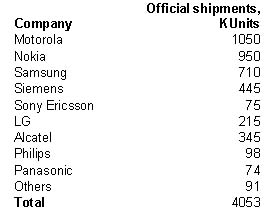
The grey market in the 4Q as well as in the 3Q was very
small. Shipments of exclusive models, really interesting for
customers but not officially announced have increased.
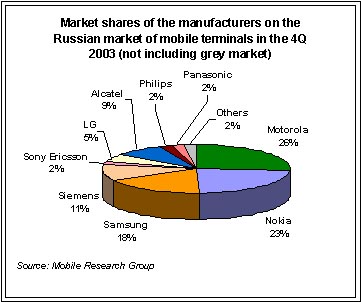
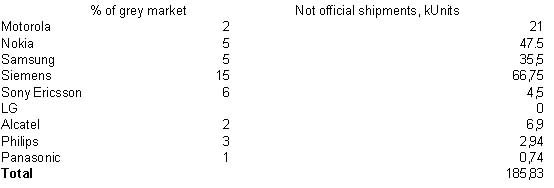
The volume of grey market in the 4Q was 4,5%. It is the
lowest value of the grey market for the last years. It proves
that mobile phones are demanded in Europe, really cheap models
are absent.
In the end of the year total market volume (including grey
market) was 15 million 117 thousand terminals. Market shares
of the companies are as follows.
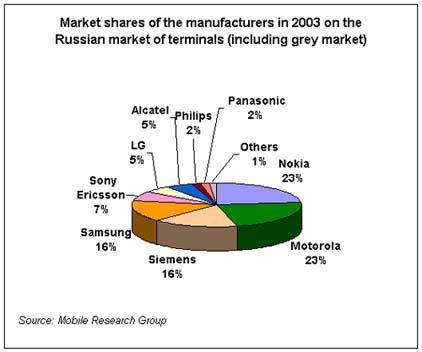
During the last quarters Motorola was the leader of the
market concerning number of shipped terminals. At the same
time Nokia had very stable positions and the success of Motorola
didn’t affect alignment of forces. Now the companies
have equal shares (the difference in 14 500 terminals is not
significant (the data include grey market!)). If the same
scenario continues next year, Nokia could stop be the leader
of the market. The company needs more low-end solutions. The
share of cheap phones on the Russian market is constant and
it will decrease in the end of the 3Q 2004.
Samsung continues to increase its sales. During the year
the company showed impressive results. Now the company occupies
16% of the market, the same share has Siemens. During 2003
German manufacturer was losing its market share due to several
reasons. The main one was lack of terminals.
Forecast for 2004
Basing on market dynamics it is possible to say that the
market will continue to grow in 2004. Mobile Research Group
estimates market of terminals in 2004 as 21,5 million. It
is an average estimation taking into account favourable macroeconomic
situation. Estimations of most vendors are about 18-19 million
of terminals. The situation of 2003, when not true forecasts
couldn’t allow some players to increase their sales,
may repeat again. In our opinion, the situation of the first
half of the year will develop according the classical scenario.
In spring the demand in the price segment of 150 USD and lower
will increase because people will go at the country to “ditches”.
The main shipments in the 1Q will begin in the middle of February,
the demand of customers will be satisfied in March. It will
be favourable conditions for overstocking. The development
of the situation will depend on the actions of the main players.
If Nokia put prices for several models down, the crisis situation
of 2003 will repeat. If not, the market will continuously
grow till the end of the year, the greatest sales will be
in the 4Q.
The struggle for the first place on the Russian market
of terminals will continue in 2004. Motorola is a favorite,
because it has a big potential for growth: strong positions
in the low-end segment, absence of expensive models in 2003…
Samsung is also a serious competitor for Nokia, because it
has products in the same segments. In the end of the first
half of the year Samsung will overpass Siemens (now the difference
is 75 000 of terminals in favour of Siemens). Speaking about
money volume, Samsung maintains the lead positions. In our
opinion in the end of 2004 the company could occupy the second
place by number of terminals and the first place by proceeds.
It will depend on Nokia’s strategy on the market.
About Mobile Research Group
The main activity of Mobile Research Group (http://www.mobile-analytics.ru)
- is mobile terminals market researches in Russia. The company
analyses the competitive situation of all mobile phones manufacturers
available on the Russian market, and researches retail and
wholesales of mobile terminals. Basing on analyzed statistic
data the company makes a forecast of the mobile terminals
market development for some period (up to one year). According
to concluded partnership agreement once a quarter the company
presents a market analysis report, where the most considerable
events and their results are marked.
Publishing data contained in this press release
without a link to the Mobile Research Group as a source of
information is prohibited. We reserve the right to change
data published above if any new circumstances or new information
earlier unknown to us arise.
© Mobile Research Group, 2004
Eldar Murtazin (eldar@mobile-review.com)
Translated by Alexander "Lexx" Zavoloka(Lexx@i-5.delfi.lv)
Published — 30 January 2004
Have something to add?! Write us... eldar@mobile-review.com
|





